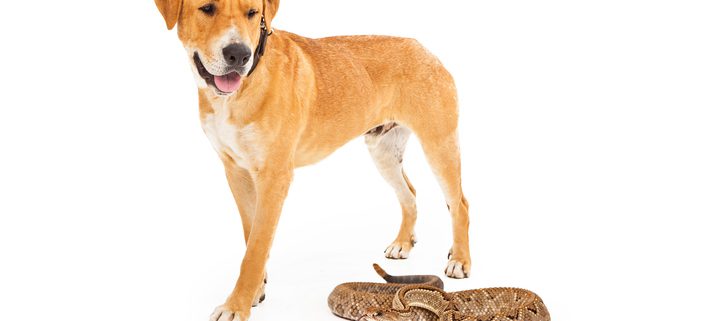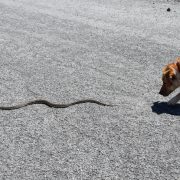9 Tips To Keep Your Pup Safe From Snake Bites
Though snakes look all sorts of evil and untrustworthy to humans, to dogs, snakes are just another animal. In other words, dogs are not protected from snakes like humans are by the knowledge of the harm they can cause. It’s up to you, Responsible Pup Parent, to know how to keep your dog out of a snake’s way. And now that summer’s here the chances of encountering a snake are only increasing.
KNOW THY ENEMY
The summer heat fosters conditions that snakes love. Dry, arid conditions allow snakes to thrive, and/or drive them into the comfort of your yard or home.
It’s also important to note that not all snakes are venomous. A good rule of thumb for identifying a venomous snake is whether it has a pronounced jaw that makes the snake’s head look like an arrowhead. That’s because the venom sacks are lodged in the snake’s jaw which causes it to stick out. Non-venomous snakes have round-shaped heads due to the lack of venom sacks.
- Consider vaccination.
Sure, this is more of a preemptive measure than a preventative one, but if you believe there’s a high likelihood of your dog being bitten because you live in an especially snake area, get them vaccinated for snake bites.
Currently, the leading snake bite vaccine is targeted to the bites of rattle snakes. Not all poisonous snakes are rattlers, but all rattlers are poisonous and they are the leading offenders. Most snake bites tend to be rattler bites.
- Keep ’em on a leash.
Don’t let your dog roam free in an area you suspect to have snakes. Even if it’s your back yard, keep your dog leashed to your chair so they don’t go sniffing in a potential snake habitat.
- Keep ’em on a SHORT leash.
If you’re concerned about your pup getting bit while on a walk, the best solution is to keep the dog on a short leash, not an extender leash, to keep them from potentially dangerous snake spots.
- Stay on trail.
If you’re out hiking, don’t wander off trail. If you’re just walking through your neighborhood, stay on the sidewalk. Snakes tend to mind their own business as long as you do, too.
- Avoid big rocks or dense grass.
Snakes are cold-blooded, so they are drawn to cool places like under rocks or deep in the long grass of an open field.
- Snake proof your yard.
Cementing your backyard fence into the ground might be too involved for you, but you can keep it clean, right? ? Keep your grass short and don’t leave anything that may attract rodents (aka snake bait). If you have firewood, stack it away from your house to keep mice from housing there.
- Condition your dog to come when it sees a snake.
Whenever you see that your dog sees a snake, call it to you. Reinforce the behavior with treats. Make going to investigate the snake seem like a real boring idea compared to all the love and treats you have to offer.
- If you hear a rattle, don’t go that way.
Or just go inside, if it’s an option. The interesting thing about rattle snakes specifically is that they really don’t want anything to do with you. They even have a noisemaker attached to its tail just so you know where they are and leave them alone. We suggest you oblige them.
- Don’t let them play with dead snakes.
It may be dead, but the venom stored in its body is as toxic as ever. If your pup accidentally chewed into the venom it would be no different than if they had been bitten.
IF THE WORST HAPPENS…
Just in case your dog ever gets bit when you’re not around, memorize these snake bite symptoms so you can identify the problem:
Swelling
Bleeding
Signs of pain
Shortness of breath
Low blood pressure
Though snakes look all sorts of evil and untrustworthy to humans, to dogs, snakes are just another animal. In other words, dogs are not protected from snakes like humans are by the knowledge of the harm they can cause. It’s up to you, Responsible Pup Parent, to know how to keep your dog out of a snake’s way. And now that summer’s here the chances of encountering a snake are only increasing.
KNOW THY ENEMY
The summer heat fosters conditions that snakes love. Dry, arid conditions allow snakes to thrive, and/or drive them into the comfort of your yard or home.
It’s also important to note that not all snakes are venomous. A good rule of thumb for identifying a venomous snake is whether it has a pronounced jaw that makes the snake’s head look like an arrowhead. That’s because the venom sacks are lodged in the snake’s jaw which causes it to stick out. Non-venomous snakes have round-shaped heads due to the lack of venom sacks.
- Consider vaccination.
Sure, this is more of a preemptive measure than a preventative one, but if you believe there’s a high likelihood of your dog being bitten because you live in an especially snake area, get them vaccinated for snake bites.
Currently, the leading snake bite vaccine is targeted to the bites of rattle snakes. Not all poisonous snakes are rattlers, but all rattlers are poisonous and they are the leading offenders. Most snake bites tend to be rattler bites.
- Keep ’em on a leash.
Don’t let your dog roam free in an area you suspect to have snakes. Even if it’s your back yard, keep your dog leashed to your chair so they don’t go sniffing in a potential snake habitat.
- Keep ’em on a SHORT leash.
If you’re concerned about your pup getting bit while on a walk, the best solution is to keep the dog on a short leash, not an extender leash, to keep them from potentially dangerous snake spots.
- Stay on trail.
If you’re out hiking, don’t wander off trail. If you’re just walking through your neighborhood, stay on the sidewalk. Snakes tend to mind their own business as long as you do, too.
- Avoid big rocks or dense grass.
Snakes are cold-blooded, so they are drawn to cool places like under rocks or deep in the long grass of an open field.
- Snake proof your yard.
Cementing your backyard fence into the ground might be too involved for you, but you can keep it clean, right? ? Keep your grass short and don’t leave anything that may attract rodents (aka snake bait). If you have firewood, stack it away from your house to keep mice from housing there.
- Condition your dog to come when it sees a snake.
Whenever you see that your dog sees a snake, call it to you. Reinforce the behavior with treats. Make going to investigate the snake seem like a real boring idea compared to all the love and treats you have to offer.
- If you hear a rattle, don’t go that way.
Or just go inside, if it’s an option. The interesting thing about rattle snakes specifically is that they really don’t want anything to do with you. They even have a noisemaker attached to its tail just so you know where they are and leave them alone. We suggest you oblige them.
- Don’t let them play with dead snakes.
It may be dead, but the venom stored in its body is as toxic as ever. If your pup accidentally chewed into the venom it would be no different than if they had been bitten.
IF THE WORST HAPPENS…
Just in case your dog ever gets bit when you’re not around, memorize these snake bite symptoms so you can identify the problem:
Swelling
Bleeding
Signs of pain
Shortness of breath
Low blood pressure
Weakness
Dead tissue surrounding wound
If you suspect your dog has been bitten seek immediate emergency veterinarian care. If you are able to kill or capture the snake then do so. Successfully identifying the snake will allow doctors to treat your pup all the better.
Weakness
Dead tissue surrounding wound
If you suspect your dog has been bitten seek immediate emergency veterinarian care. If you are able to kill or capture the snake then do so. Successfully identifying the snake will allow doctors to treat your pup all the better.




